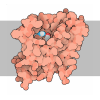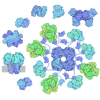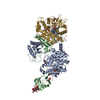[English] 日本語
 Yorodumi
Yorodumi- PDB-7jhh: Cryo-EM structure of ATP-bound fully inactive AMPK in complex wit... -
+ Open data
Open data
- Basic information
Basic information
| Entry | Database: PDB / ID: 7jhh | |||||||||
|---|---|---|---|---|---|---|---|---|---|---|
| Title | Cryo-EM structure of ATP-bound fully inactive AMPK in complex with Fab and nanobody | |||||||||
 Components Components |
| |||||||||
 Keywords Keywords | TRANSFERASE/IMMUNE SYSTEM / AMPK / ATP / fully inactive / KD-displaced / TRANSFERASE-IMMUNE SYSTEM complex | |||||||||
| Function / homology |  Function and homology information Function and homology informationnegative regulation of glucosylceramide biosynthetic process / [hydroxymethylglutaryl-CoA reductase (NADPH)] kinase / [hydroxymethylglutaryl-CoA reductase (NADPH)] kinase activity / regulation of stress granule assembly / positive regulation of mitochondrial transcription / AMPK inhibits chREBP transcriptional activation activity / histone H2BS36 kinase activity / cold acclimation / cAMP-dependent protein kinase regulator activity / AMP-activated protein kinase activity ...negative regulation of glucosylceramide biosynthetic process / [hydroxymethylglutaryl-CoA reductase (NADPH)] kinase / [hydroxymethylglutaryl-CoA reductase (NADPH)] kinase activity / regulation of stress granule assembly / positive regulation of mitochondrial transcription / AMPK inhibits chREBP transcriptional activation activity / histone H2BS36 kinase activity / cold acclimation / cAMP-dependent protein kinase regulator activity / AMP-activated protein kinase activity / lipid droplet disassembly / Lipophagy / regulation of carbon utilization / positive regulation of skeletal muscle tissue development / CAMKK-AMPK signaling cascade / import into nucleus / regulation of vesicle-mediated transport / nucleotide-activated protein kinase complex / negative regulation of hepatocyte apoptotic process / Energy dependent regulation of mTOR by LKB1-AMPK / Carnitine shuttle / positive regulation of T cell mediated immune response to tumor cell / tau-protein kinase / protein kinase regulator activity / negative regulation of TOR signaling / Activation of PPARGC1A (PGC-1alpha) by phosphorylation / response to caffeine / positive regulation of protein targeting to mitochondrion / regulation of glycolytic process / cAMP-dependent protein kinase activity / protein localization to lipid droplet / tau-protein kinase activity / negative regulation of tubulin deacetylation / AMP binding / cellular response to stress / Macroautophagy / cholesterol biosynthetic process / lipid biosynthetic process / fatty acid oxidation / motor behavior / positive regulation of protein kinase activity / cellular response to ethanol / carbohydrate transmembrane transporter activity / maltose binding / maltose transport / maltodextrin transmembrane transport / fatty acid homeostasis / negative regulation of lipid catabolic process / cellular response to nutrient levels / response to UV / cellular response to glucose starvation / energy homeostasis / Activation of AMPK downstream of NMDARs / ATP-binding cassette (ABC) transporter complex, substrate-binding subunit-containing / positive regulation of protein localization / negative regulation of TORC1 signaling / positive regulation of adipose tissue development / positive regulation of gluconeogenesis / positive regulation of autophagy / negative regulation of insulin receptor signaling pathway / cellular response to calcium ion / regulation of microtubule cytoskeleton organization / positive regulation of glycolytic process / response to activity / response to gamma radiation / TP53 Regulates Metabolic Genes / Translocation of SLC2A4 (GLUT4) to the plasma membrane / cellular response to glucose stimulus / positive regulation of cholesterol biosynthetic process / regulation of circadian rhythm / neuron cellular homeostasis / ADP binding / positive regulation of T cell activation / autophagy / response to estrogen / tau protein binding / cellular response to xenobiotic stimulus / Wnt signaling pathway / cellular response to hydrogen peroxide / glucose metabolic process / fatty acid biosynthetic process / rhythmic process / glucose homeostasis / cellular response to prostaglandin E stimulus / positive regulation of cold-induced thermogenesis / outer membrane-bounded periplasmic space / cellular response to oxidative stress / spermatogenesis / cellular response to hypoxia / Regulation of TP53 Activity through Phosphorylation / response to hypoxia / protein phosphorylation / non-specific serine/threonine protein kinase / protein kinase activity / regulation of cell cycle / nuclear speck / cilium / ciliary basal body / apical plasma membrane / axon Similarity search - Function | |||||||||
| Biological species |  Homo sapiens (human) Homo sapiens (human) synthetic construct (others) | |||||||||
| Method | ELECTRON MICROSCOPY / single particle reconstruction / cryo EM / Resolution: 3.92 Å | |||||||||
 Authors Authors | Yan, Y. / Murkherjee, S. / Zhou, X.E. / Xu, T.H. / Xu, H.E. / Kossiakoff, A.A. / Melcher, K. | |||||||||
| Funding support |  United States, 2items United States, 2items
| |||||||||
 Citation Citation |  Journal: Science / Year: 2021 Journal: Science / Year: 2021Title: Structure of an AMPK complex in an inactive, ATP-bound state. Authors: Yan Yan / Somnath Mukherjee / Kaleeckal G Harikumar / Timothy S Strutzenberg / X Edward Zhou / Kelly Suino-Powell / Ting-Hai Xu / Ryan D Sheldon / Jared Lamp / Joseph S Brunzelle / Katarzyna ...Authors: Yan Yan / Somnath Mukherjee / Kaleeckal G Harikumar / Timothy S Strutzenberg / X Edward Zhou / Kelly Suino-Powell / Ting-Hai Xu / Ryan D Sheldon / Jared Lamp / Joseph S Brunzelle / Katarzyna Radziwon / Abigail Ellis / Scott J Novick / Irving E Vega / Russell G Jones / Laurence J Miller / H Eric Xu / Patrick R Griffin / Anthony A Kossiakoff / Karsten Melcher /   Abstract: Adenosine monophosphate (AMP)-activated protein kinase (AMPK) regulates metabolism in response to the cellular energy states. Under energy stress, AMP stabilizes the active AMPK conformation, in ...Adenosine monophosphate (AMP)-activated protein kinase (AMPK) regulates metabolism in response to the cellular energy states. Under energy stress, AMP stabilizes the active AMPK conformation, in which the kinase activation loop (AL) is protected from protein phosphatases, thus keeping the AL in its active, phosphorylated state. At low AMP:ATP (adenosine triphosphate) ratios, ATP inhibits AMPK by increasing AL dynamics and accessibility. We developed conformation-specific antibodies to trap ATP-bound AMPK in a fully inactive, dynamic state and determined its structure at 3.5-angstrom resolution using cryo-electron microscopy. A 180° rotation and 100-angstrom displacement of the kinase domain fully exposes the AL. On the basis of the structure and supporting biophysical data, we propose a multistep mechanism explaining how adenine nucleotides and pharmacological agonists modulate AMPK activity by altering AL phosphorylation and accessibility. | |||||||||
| History |
|
- Structure visualization
Structure visualization
| Movie |
 Movie viewer Movie viewer |
|---|---|
| Structure viewer | Molecule:  Molmil Molmil Jmol/JSmol Jmol/JSmol |
- Downloads & links
Downloads & links
- Download
Download
| PDBx/mmCIF format |  7jhh.cif.gz 7jhh.cif.gz | 320.2 KB | Display |  PDBx/mmCIF format PDBx/mmCIF format |
|---|---|---|---|---|
| PDB format |  pdb7jhh.ent.gz pdb7jhh.ent.gz | 248 KB | Display |  PDB format PDB format |
| PDBx/mmJSON format |  7jhh.json.gz 7jhh.json.gz | Tree view |  PDBx/mmJSON format PDBx/mmJSON format | |
| Others |  Other downloads Other downloads |
-Validation report
| Summary document |  7jhh_validation.pdf.gz 7jhh_validation.pdf.gz | 1 MB | Display |  wwPDB validaton report wwPDB validaton report |
|---|---|---|---|---|
| Full document |  7jhh_full_validation.pdf.gz 7jhh_full_validation.pdf.gz | 1 MB | Display | |
| Data in XML |  7jhh_validation.xml.gz 7jhh_validation.xml.gz | 52.8 KB | Display | |
| Data in CIF |  7jhh_validation.cif.gz 7jhh_validation.cif.gz | 80.6 KB | Display | |
| Arichive directory |  https://data.pdbj.org/pub/pdb/validation_reports/jh/7jhh https://data.pdbj.org/pub/pdb/validation_reports/jh/7jhh ftp://data.pdbj.org/pub/pdb/validation_reports/jh/7jhh ftp://data.pdbj.org/pub/pdb/validation_reports/jh/7jhh | HTTPS FTP |
-Related structure data
| Related structure data |  22337MC  7jhgC  7jijC  7m74C C: citing same article ( M: map data used to model this data |
|---|---|
| Similar structure data |
- Links
Links
- Assembly
Assembly
| Deposited unit | 
|
|---|---|
| 1 |
|
- Components
Components
-Protein , 2 types, 2 molecules AM
| #1: Protein | Mass: 56004.395 Da / Num. of mol.: 1 / Fragment: UNP residues 22-480,535-559 Source method: isolated from a genetically manipulated source Source: (gene. exp.)  Homo sapiens (human) / Gene: PRKAA1, AMPK1 / Production host: Homo sapiens (human) / Gene: PRKAA1, AMPK1 / Production host:  References: UniProt: Q13131, non-specific serine/threonine protein kinase, EC: 2.7.11.27, [hydroxymethylglutaryl-CoA reductase (NADPH)] kinase, tau-protein kinase |
|---|---|
| #4: Protein | Mass: 40827.125 Da / Num. of mol.: 1 Source method: isolated from a genetically manipulated source Source: (gene. exp.)   |
-5'-AMP-activated protein kinase subunit ... , 2 types, 2 molecules BG
| #2: Protein | Mass: 22384.650 Da / Num. of mol.: 1 Source method: isolated from a genetically manipulated source Source: (gene. exp.)  Homo sapiens (human) / Gene: PRKAB2 / Production host: Homo sapiens (human) / Gene: PRKAB2 / Production host:  |
|---|---|
| #3: Protein | Mass: 34833.359 Da / Num. of mol.: 1 Source method: isolated from a genetically manipulated source Source: (gene. exp.)  Homo sapiens (human) / Gene: PRKAG1 / Production host: Homo sapiens (human) / Gene: PRKAG1 / Production host:  |
-Antibody , 3 types, 3 molecules LHN
| #5: Antibody | Mass: 23212.715 Da / Num. of mol.: 1 Source method: isolated from a genetically manipulated source Source: (gene. exp.) synthetic construct (others) / Production host:  |
|---|---|
| #6: Antibody | Mass: 25483.488 Da / Num. of mol.: 1 Source method: isolated from a genetically manipulated source Source: (gene. exp.) synthetic construct (others) / Production host:  |
| #7: Antibody | Mass: 17414.383 Da / Num. of mol.: 1 Source method: isolated from a genetically manipulated source Source: (gene. exp.) synthetic construct (others) / Production host:  |
-Sugars , 1 types, 1 molecules
| #8: Polysaccharide | alpha-D-glucopyranose-(1-4)-alpha-D-glucopyranose |
|---|
-Non-polymers , 3 types, 3 molecules 

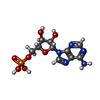


| #9: Chemical | ChemComp-ATP / |
|---|---|
| #10: Chemical | ChemComp-ADP / |
| #11: Chemical | ChemComp-AMP / |
-Details
| Has ligand of interest | Y |
|---|---|
| Has protein modification | Y |
-Experimental details
-Experiment
| Experiment | Method: ELECTRON MICROSCOPY |
|---|---|
| EM experiment | Aggregation state: PARTICLE / 3D reconstruction method: single particle reconstruction |
- Sample preparation
Sample preparation
| Component |
| ||||||||||||||||||||||||
|---|---|---|---|---|---|---|---|---|---|---|---|---|---|---|---|---|---|---|---|---|---|---|---|---|---|
| Molecular weight | Value: 0.22 MDa / Experimental value: NO | ||||||||||||||||||||||||
| Source (natural) |
| ||||||||||||||||||||||||
| Source (recombinant) |
| ||||||||||||||||||||||||
| Buffer solution | pH: 8 | ||||||||||||||||||||||||
| Specimen | Embedding applied: NO / Shadowing applied: NO / Staining applied: NO / Vitrification applied: YES | ||||||||||||||||||||||||
| Specimen support | Details: unspecified | ||||||||||||||||||||||||
| Vitrification | Instrument: FEI VITROBOT MARK IV / Cryogen name: ETHANE / Humidity: 100 % / Chamber temperature: 281 K |
- Electron microscopy imaging
Electron microscopy imaging
| Experimental equipment |  Model: Titan Krios / Image courtesy: FEI Company |
|---|---|
| Microscopy | Model: FEI TITAN KRIOS |
| Electron gun | Electron source:  FIELD EMISSION GUN / Accelerating voltage: 300 kV / Illumination mode: FLOOD BEAM FIELD EMISSION GUN / Accelerating voltage: 300 kV / Illumination mode: FLOOD BEAM |
| Electron lens | Mode: BRIGHT FIELD / Cs: 2.7 mm |
| Specimen holder | Cryogen: NITROGEN |
| Image recording | Average exposure time: 0.2 sec. / Electron dose: 88 e/Å2 / Detector mode: SUPER-RESOLUTION / Film or detector model: GATAN K2 SUMMIT (4k x 4k) / Num. of real images: 7659 |
- Processing
Processing
| Software | Name: PHENIX / Version: 1.13_2998: / Classification: refinement | ||||||||||||||||||||||||||||
|---|---|---|---|---|---|---|---|---|---|---|---|---|---|---|---|---|---|---|---|---|---|---|---|---|---|---|---|---|---|
| EM software |
| ||||||||||||||||||||||||||||
| CTF correction | Type: PHASE FLIPPING AND AMPLITUDE CORRECTION | ||||||||||||||||||||||||||||
| Particle selection | Num. of particles selected: 1501939 | ||||||||||||||||||||||||||||
| 3D reconstruction | Resolution: 3.92 Å / Resolution method: FSC 0.143 CUT-OFF / Num. of particles: 360824 / Symmetry type: POINT | ||||||||||||||||||||||||||||
| Atomic model building |
|
 Movie
Movie Controller
Controller





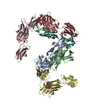

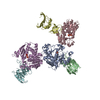


 PDBj
PDBj


